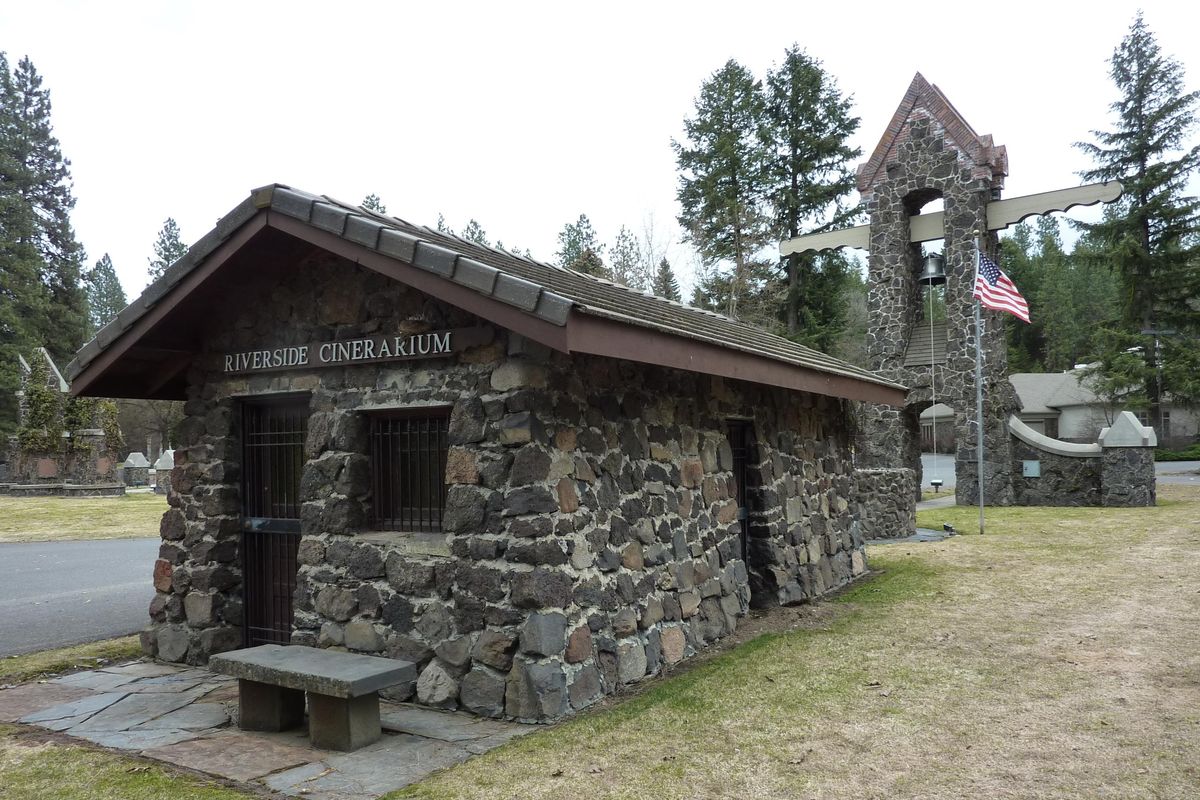Kirtland Cutter-designed cinerarium at Riverside Memorial Park may be eligible for National Register of Historic Places

Within Riverside Memorial Park are several large and elegant mausoleums containing the remains of some noted individuals and families from the region’s early development, including Louis Davenport and the August Paulsen family. But also, not far from Riverside’s main entry, is a smaller, unassuming and easy-to-overlook structure – the cinerarium.
Cinerariums are mausoleums designed to house the cremated remains of the dead. The word itself comes from the late 19th century Latin term cinerarius, meaning “of ashes.”
Riverside’s cinerarium and the original carriage house just to the west of it come with a pretty good pedigree, having been designed by noted early Spokane architect Kirtland Cutter, who also designed the entry way into the cemetery, according to Deny York, CEO of Riverside’s parent company, Fairmount Memorial Association. He added that the original entry way was taken down in 1995, when the Heritage Funeral Home was built.
The little cinerarium at Riverside was likely built in 1910, according to records, three years after Riverside Park Company bought land at the site at 211 N. Government Way for a recreational municipal park. In 1914, the land became a cemetery, Riverside Park Cemetery, and the name held until it was changed to Riverside Memorial Park in 1962. It became part of the Fairmount organization in 1975.
The cinerarium is built of large pieces of basalt rubble held together by clearly visible mortar. It’s likely the oldest – as well as the smallest and least ornamental – of the mausoleums in both Riverside Memorial Park and its neighboring Greenwood Memorial Terrace, said Stephen Emerson, director of Archisto Enterprises. The Spokane archeological research company conducted a recent survey of rock structures in the county for the City/County Historic Landmarks Commission and City/County Historic Preservation Office.
The reason for the utilitarian design of the cinerarium may be that its original use was for something else. “It was probably a restroom early on,” said Troy Hoerner, grounds superintendent at Riverside.
Indeed, the building has three entry doors, two of which lead to small interior rooms, and the third gives entry into what appears to be a closet-sized area that perhaps provided mechanical access to the back sides of men’s and women’s bathrooms. In one of the rooms, there remain marks on the walls suggesting where a bathroom stall might have been and where a sink was mounted, Hoerner pointed out.
The cinerarium, covered in ivy in several places, served as a maintenance building for a number of years. In the early 2000s, shelving was installed in one of the rooms and the cinerarium function was established. Originally, it was for the temporary storage of cremated remains “until the family decided upon the final resting place,” said David Ittner, Fairmount’s chief operating officer. “The fee they paid would be applied toward the purchase of a permanent spot. However, over the years, it has become a more permanent option.”
There are 19 cremated remains housed inside the cinerarium. Just outside are two tall basalt columns containing the names of 26 individuals, 25 on one column and one on the other. Hoerner said four are memorials for persons interred elsewhere and five are for those still living but who have reserved space within, with only their birth dates listed on the plaques. And there have been a few urns placed in the cinerarium recently for which memorial plaques have not yet been installed.
The cinerarium lettering was removed in recent years from the east side of the building and mounted on a piece of wood crafted by Hoerner, the ends of which have the same shape as the bell tower that stands between it and the cemetery’s entrance. The new sign was moved to the building’s north side, and a bird has found the location suitable for building a nest just above the lettering.
Not grand or elegant in any way, the building is something special, according to Stephen Emerson: “Because of being an intact example of basalt rubble construction and as a contributing feature of one of Spokane’s oldest and most prominent cemeteries, the little cinerarium appears to be eligible for listing on the National Register of Historic Places.”
Should that happen, it would be in the company of other grander and more famous Kirtland Cutter-designed structures in Spokane, such as the Campbell House, Clark Mansion, Corbin Arts Center and Davenport Hotel.